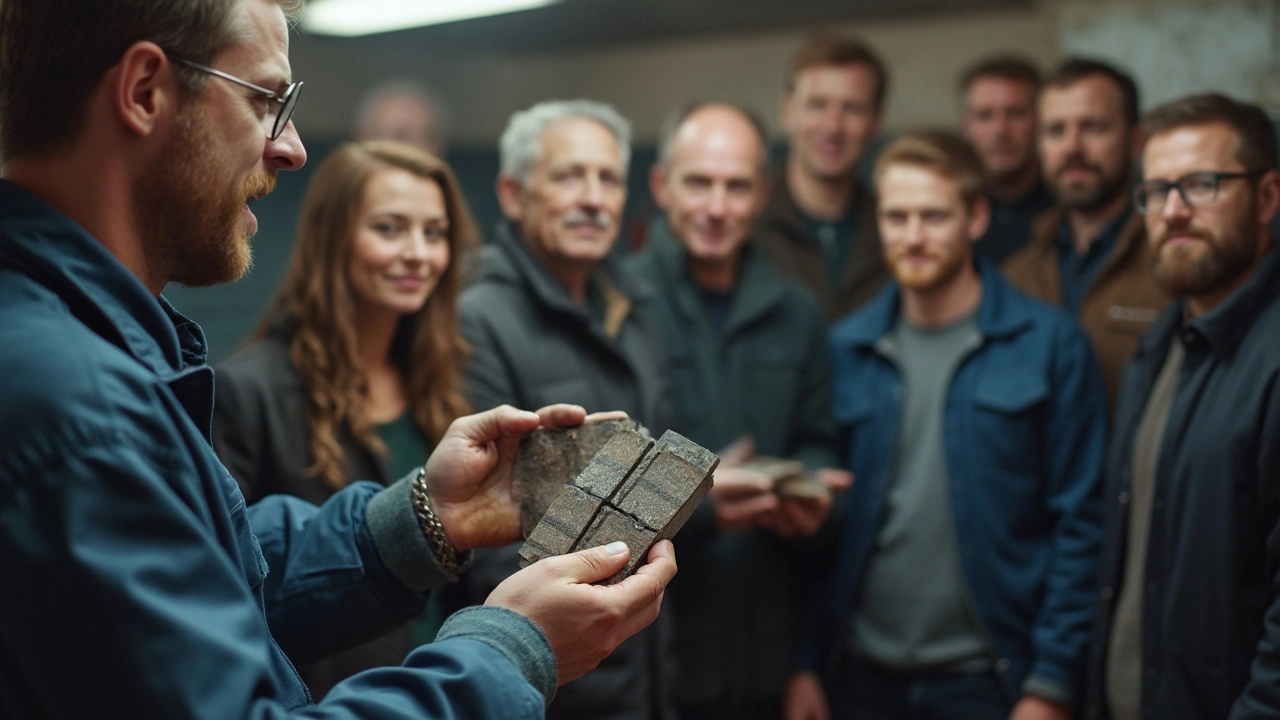Ever had your car let out a loud screech when you stop at a red light? That noise could be your brake pads waving a red flag. Brake pads don’t just wear down overnight, but when they do start to get thin, they’ll usually send out some signals you can see, hear, or feel—if you know what to look for. Ignoring the warning signs can risk your safety and end up costing way more later on.
The cool thing is, you don’t have to be a mechanic to spot early signs of bad brake pads. Squeaks, longer stopping distances, and even changes in the way your brake pedal feels can all be dead giveaways. Modern cars add even more hints, like dashboard lights you shouldn't brush off. Trust those clues—your brakes do a lot more than just slow you down. Catch issues fast, and you’ll save yourself from both danger and a surprise at the auto shop.
- Squeaks, Squeals, and Strange Sounds
- Feeling Through the Pedal: Vibrations and Softness
- Warning Lights and Dashboard Clues
- Inspecting the Brake Pads Yourself
- What Happens if You Ignore Bad Brake Pads?
Squeaks, Squeals, and Strange Sounds
If you drive with the radio off and suddenly hear an annoying squeak or a high-pitched squeal every time you press the brake, don’t just blame the weather. Those sounds are the classic early warning signals that your brake pads are getting worn down. Most modern brake pads actually come with built-in metal indicators that start scraping against the rotor when the pad material gets too thin, making that unmistakable squeal on purpose. It’s basically the car’s way of saying: “Hey, time to pay attention!”
Hear grinding instead of squealing? That’s even worse news. It often means the pad’s completely shot and the metal backing is now pushing straight into your rotor. That can quickly turn a cheap brake pads swap into a huge repair bill, since rotors aren’t cheap to replace. A clunk, rattle, or odd vibrations can also pop up if a brake pad has worn unevenly or even come loose.
Here’s what to listen for and what it usually means:
- Squealing or squeaking when braking: Pads probably getting thin, time for a check.
- Grinding noise when braking: Pad might be totally worn out, rotor could be getting damaged.
- Rattling, clicking, or clunking: Could be a loose or broken pad, which isn’t just annoying—it’s dangerous.
- Squeaks right after rain or washing: Sometimes harmless, as water can cause temporary squeaking, but it should go away quickly.
One interesting thing—according to a recent survey by a popular auto repair network, more than 60% of drivers ignore odd brake noises for two weeks or longer, hoping they’ll magically disappear. Spoiler: they never do and things usually get messier if left unchecked.
Any sound that’s new, persistent, or getting worse means you should check your brake pads as soon as possible. If you’re not sure what you’re hearing, get a second opinion. Catching those sounds early saves money and keeps you safer on the road.
Feeling Through the Pedal: Vibrations and Softness
Your brake pedal can tell you a lot about the shape your brake pads are in—if you pay attention. When you press down and feel a pulsing or vibration that shouldn't be there, that’s not just your imagination. Worn brake pads or uneven rotors often cause this shaky feeling. Sometimes, the pad wears down unevenly or glaze over, so when the pad grabs the rotor, it vibrates or pulses right through the pedal.
Another red flag is a brake pedal that suddenly feels softer or spongier than it used to. If it takes extra pressure to slow down or stop, don’t just get used to it—this often means your brake pads are low or there’s air or moisture in the brake lines. In both cases, your stopping power drops, which isn’t something you want to gamble on in real traffic.
- Vibrations mostly happen because the pad surface is no longer even, or the rotor (the part the pad clamps on) has worn in a lopsided way.
- Soft or spongy brakes can also point to other problems, but thin brake pads are a top culprit.
- If you hear a grind along with the vibrations—or the pedal hits the floor—that’s an emergency. Get your car checked before driving any further.
Did you know a study from AAA once found that worn-out brake pads can increase your stopping distance by up to 20%? In real terms, that means the difference between stopping safely at a crosswalk or rolling right through it. Bottom line: Know how your brake pedal usually feels. If something gets weird—vibrations, softness, more travel before brakes grab—it’s usually your car’s way of asking for a pad check.

Warning Lights and Dashboard Clues
Most modern cars don’t leave you guessing when your brake pads or overall brake system isn't right. If you spot a glowing brake warning light or an ABS (Anti-lock Braking System) icon on your dash, don’t shrug it off. These lights are there for a reason and can signal everything from low brake fluid to worn-out brake pads. Some cars even have a dedicated pad wear sensor, which triggers a light once the pads get dangerously thin.
Here’s what you might see:
- Brake warning light: Usually looks like a circle with an exclamation point or the word "BRAKE". This light can mean your brake fluid is low or your brake pads are shot.
- ABS light: Indicates an issue with the anti-lock system, which sometimes relates to problems with worn brake pads.
- Pad wear indicator light: Not every car has this. When it lights up, your pads need replacing pretty much immediately.
Don’t bet on driving for miles with a warning light on—some brake problems get worse really fast. According to AAA, ignoring warning lights is one of the top causes for major brake system failures that end up roadside. And here’s a quick data check:
| Dashboard Light | Possible Cause | Urgency |
|---|---|---|
| Brake Light | Low fluid, worn pads, system fault | High—check ASAP |
| ABS Light | ABS system fault, pad wear (in some cars) | Medium to High |
| Pad Wear Light | Worn brake pads | Immediate—replace pads |
The bottom line: if you see a dashboard alert related to your brakes, check your owner’s manual and get it inspected as soon as you can. These clues save lives and wallets—dash lights are basically your car’s way of saying “help me out, now!”
Inspecting the Brake Pads Yourself
You don’t need fancy gear or a mechanic’s background to check your brake pads at home. Grab a flashlight and, if you can, a jack to lift the car so you can peek through the wheels. Most cars let you spot the pads right through the spokes, though some wheels block the view. Here’s the no-nonsense way anyone can do a quick brake check.
- Turn the steering wheel to one side if checking the front wheels—it gives you a better view.
- Look for the actual brake pads: they’re the flat, slightly curved pieces pressing against the shiny metal rotor.
- If there’s less than a quarter-inch (about 6mm) of pad left, it’s time to swap them out. Super thin means you’re pushing your luck.
A lot of new pad sets include a tiny metal clip, called a wear indicator, that squeals when the pad gets low. But even without the noise, you can often see for yourself how much material is left.
| Brake Pad Thickness | Action Needed |
|---|---|
| More than 6mm | Good to go |
| 3-6mm | Start planning a replacement |
| Less than 3mm | Replace ASAP |
Keep an eye out for grooves, cracks, or uneven wear on the pads. Any of these mean you’re past due for a brake job. By the way, don’t ignore the rear brakes—those wear out too, just often a bit slower.
Sometimes the pads aren’t easy to see, or maybe you’re not sure what you’re looking at. No shame in that. Take a quick snapshot and show it to a pro for a second opinion.
"If you can slide a credit card’s thickness between the rotor and backing plate, your brake pads are ready for retirement. Don’t push it beyond that point—safety isn’t worth the gamble." — James O’Donnell, ASE Certified Master Technician
Checking your brake pads is quick, saves cash, and helps you dodge bigger headaches down the road. If in doubt, get a pro to take a look—better safe than sorry!

What Happens if You Ignore Bad Brake Pads?
Treating worn brake pads like they’re just another rattly noise is a recipe for headaches—sometimes literally. Letting your brake pads go bad means you’re gambling with your car’s ability to stop, and nobody wants to roll those dice.
First, here’s what really happens. When pads wear thin, the metal underneath can scrape directly against the brake rotor. That’s not just noisy—it’s damaging. You’ll get less stopping power and increase your stopping distance, which could mean the difference between a close call and a crash. According to insurance industry data, bad brakes are linked to over 20,000 collisions a year in the US alone. That’s proof the risk is real, not just a scare tactic.
If you keep ignoring those brake problems, the costs pile up:
- Warped or damaged rotors: Thin pads let metal grind on metal. Rotors get scored or warped—fixing that is way pricier than changing pads.
- More expensive repairs: Problem pads can damage other parts like calipers, too.
- Noisy, embarrassing stops: When brakes squeal, grind, or growl, everyone around notices—and it’s no fun explaining it.
- Worse gas mileage: Bad pads can make your brakes drag, meaning your car works harder just to roll down the road.
- Failed safety inspections: In lots of places, you can’t renew your tags if your brakes won’t pass a check.
Here’s a quick look at how the costs compare if you fix worn brake pads now versus later:
| Repair Needed | Typical Cost (USD) |
|---|---|
| Replace Brake Pads Only | $150-300 |
| Rotors + Pads Replacement | $400-800 |
| Full Brake System Repair | $900+ |
So yeah, waiting to deal with worn brake pads really doesn’t pay off. Your wallet, your nerves, and your safety are all better off if you check your pads at the first sign of trouble. If you hear that squeal, feel extra pedal mush, or spot a warning light, don’t ignore it—get your brakes checked as soon as possible.




